Multi-Objective Flight Altitude Decision Considering Contrails, Fuel Consumption and Flight Time
Abstract
:1. Introduction
- Based on empirical data collected from Chinese observation stations and contrail models reported in the review of literature, a new framework for analysing the probability of contrail formation at distinct geographical locations and altitudes is presented.
- The optimisation problem proposed in this paper seeks a balance between flight time, fuel consumption and contrail length, by quantitatively analysing their trade-off. The optimisation framework allows decision-makers to trade off different objectives to cope with scenarios oriented towards specific stakeholders.
- Empirical data from China were used to estimate the probability of contrail formation and compare the results across different geographic locations and months. The results showed a significant variation of the contrail formation by area and season. Such findings suggest a great potential for flight trajectory optimisation, which was established by the realistic estimation of contrail formation.
2. Contrail and Fuel Consumption Models
2.1. Contrail Formation Model
2.2. Speed and Flying Time Models
2.3. Fuel Consumption Model
3. Multi-Objective Optimisation Problem
3.1. Variables and Parameters
| Index of flight altitude | |
| Index of flight leg | |
| Altitude (indexed by ) of flight cruising in leg | |
| True airspeed of the flight cruising in leg at altitude . |
3.2. Objective Function
3.3. Constraints
3.4. Solution Method
4. Case Study
4.1. Seven Flight Information Regions in China Document Text
4.2. Altitude and Thickness of PCFA
4.3. Spatial Distribution of PCFA
4.4. Numerical Studies
4.4.1. Contrail Weight and Leg Number
4.4.2. Leg Number
4.4.3. Sensitivity Analysis
5. Discussion
6. Conclusions
Author Contributions
Funding
Acknowledgments
Conflicts of Interest
References
- Huls, D. Current Market Outlook 2014–2033; Boeing Commercial Airplanes: Seattle, WA, USA, 2014. [Google Scholar]
- Airbus, S. Global Market Forecast-Flying on demand 2014–2033; Airbus SAS: Blagnac Cedex, France, 2014. [Google Scholar]
- Lee, C.K.M.; Ng, K.K.H.; Chan, H.K.; Choy, K.L.; Tai, W.C.; Choi, L.S. A multi-group analysis of social media engagement and loyalty constructs between full-service and low-cost carriers in Hong Kong. J. Air Transp. Manag. 2018, 73, 46–57. [Google Scholar] [CrossRef]
- Airbus, G.M.F. Growing Horizons 2017–2036; Airbus: Toulouse, France, 2017. [Google Scholar]
- Ng, K.K.H.; Lee, C.K.M.; Chan, F.T.S.; Lv, Y. Review on meta-heuristics approaches for airside operation research. Appl. Soft Comput. 2018, 66, 104–133. [Google Scholar] [CrossRef]
- Li, F.; Lee, C.-H.; Chen, C.-H.; Khoo, L.P. Hybrid data-driven vigilance model in traffic control center using eye-tracking data and context data. Adv. Eng. Inform. 2019, 42, 100940. [Google Scholar] [CrossRef]
- Li, F.; Chen, C.-H.; Xu, G.; Khoo, L.P.; Liu, Y. Proactive mental fatigue detection of traffic control operators using bagged trees and gaze-bin analysis. Adv. Eng. Inform. 2019, 42, 100987. [Google Scholar] [CrossRef]
- Du, S.; Razavi, S. Fault-tolerant control of variable speed limits for freeway work zone using likelihood estimation. Adv. Eng. Inform. 2020, 45, 101133. [Google Scholar] [CrossRef]
- Ng, K.K.H.; Lee, C.K.M.; Zhang, S.Z.; Wu, K.; Ho, W. A multiple colonies artificial bee colony algorithm for a capacitated vehicle routing problem and re-routing strategies under time-dependent traffic congestion. Comput. Ind. Eng. 2017, 109, 151–168. [Google Scholar] [CrossRef]
- Kampa, M.; Castanas, E. Human health effects of air pollution. Environ. Pollut. 2008, 151, 362–367. [Google Scholar] [CrossRef]
- International Civil Aviation Organization (ICAO). 2016 Environmental Report; ICAO Web: Hong Kong, China, 2016. [Google Scholar]
- Postorino, M.N.; Mantecchini, L. An Element-by-Element Approach for a Holistic Estimation of the Airport Carbon Footprint. In Sustainable Aviation; Springer: Berlin/Heidelberg, Germany, 2020; pp. 193–214. [Google Scholar]
- Lee, D.S.; Fahey, D.W.; Forster, P.M.; Newton, P.J.; Wit, R.C.N.; Lim, L.L.; Owen, B.; Sausen, R. Aviation and global climate change in the 21st century. Atmos. Environ. 2009, 43, 3520–3537. [Google Scholar] [CrossRef] [Green Version]
- Government of the United Kingdom. Royal Commission on Environmental Pollution Special report. In The Environmental Effects of Civil Aircraft in Flight; Royal Commission on Environmental Pollution: London, UK, 2003. [Google Scholar]
- Holmes, C.D.; Tang, Q.; Prather, M.J. Uncertainties in climate assessment for the case of aviation NO. Proc. Natl. Acad. Sci. USA 2011, 108, 10997–11002. [Google Scholar] [CrossRef] [Green Version]
- Lee, D.-S.; Gonzalez, L.F.; Walker, R.; Periaux, J.; Onate, E. Reduction environmental effects of civil aircraft through multi-objective flight plan optimisation. In IOP Conference Series: Materials Science and Engineering; IOP Publishing: Sydney, Australia, 2010; p. 012197. [Google Scholar]
- Köhler, M.O.; Rädel, G.; Shine, K.P.; Rogers, H.L.; Pyle, J.A. Latitudinal variation of the effect of aviation NOx emissions on atmospheric ozone and methane and related climate metrics. Atmos. Environ. 2013, 64, 1–9. [Google Scholar] [CrossRef]
- Baumgardner, D.; Miake-Lye, R.C.; Anderson, M.R.; Brown, R.C. An evaluation of the temperature, water vapor, and vertical velocity structure of aircraft contrails. J. Geophys. Res. Atmos. 1998, 103, 8727–8736. [Google Scholar] [CrossRef]
- Chow, S.Y.A. Aviation and city’s climate change policies: An analysis of emissions and emission inventory of Hong Kong. In Proceedings of the 16th International Conference of Hong Kong Society for Transportation Studies, Hong Kong, China, 17–20 December 2011. [Google Scholar]
- Lee, H.; Li, G.; Rai, A.; Chattopadhyay, A. Real-time anomaly detection framework using a support vector regression for the safety monitoring of commercial aircraft. Adv. Eng. Inform. 2020, 44, 101071. [Google Scholar] [CrossRef]
- Wee, H.J.; Lye, S.W.; Pinheiro, J.-P. An integrated highly synchronous, high resolution, real time eye tracking system for dynamic flight movement. Adv. Eng. Inform. 2019, 41, 100919. [Google Scholar] [CrossRef]
- Postorino, M.N.; Mantecchini, L. A transport carbon footprint methodology to assess airport carbon emissions. J. Air Transp. Manag. 2014, 37, 76–86. [Google Scholar] [CrossRef]
- Schmidt, E. Die entstehung von eisnebel aus den auspuffgasen von flugmotoren. Schr. Dtsch. Akad. Luftfahrtforsch. Verl. R. Oldenbourg München Heft 44 1941, 5, 1–15. [Google Scholar]
- Appleman, H. The formation of exhaust condensation trails by jet aircraft. Bull. Am. Meteorol. Soc. 1953, 34, 14–20. [Google Scholar] [CrossRef] [Green Version]
- Lim, Y.; Gardi, A.; Sabatini, R. Modelling and evaluation of aircraft contrails for 4-dimensional trajectory optimisation. SAE Int. J. Aerosp. 2015, 8, 1–12. [Google Scholar] [CrossRef]
- Schumann, U. Formation, properties and climatic effects of contrails. Comptes Rendus Phys. 2005, 6, 549–565. [Google Scholar] [CrossRef]
- Djojodihardjo, H. Climate change creativity for cirrus clouds and contrails control. In 2015 International Conference on Space Science and Communication (IconSpace); IEEE: Piscataway, NJ, USA, 2015; pp. 503–508. [Google Scholar]
- Mannstein, H.; Schumann, U. Aircraft induced contrail cirrus over Europe. Meteorol. Z. 2005, 14, 549–554. [Google Scholar] [CrossRef] [Green Version]
- Green, J. Air Travel-Greener by Design. Mitigating the environmental impact of aviation: Opportunities and priorities. Aeronaut. J. 2005, 109, 361–418. [Google Scholar]
- Soler, M.; Zou, B.; Hansen, M. Flight trajectory design in the presence of contrails: Application of a multiphase mixed-integer optimal control approach. Transp. Res. Part C Emerg. Technol. 2014, 48, 172–194. [Google Scholar] [CrossRef]
- Jansen, J.; Heymsfield, A.J. Microphysics of aerodynamic contrail formation processes. J. Atmos. Sci. 2015, 72, 3293–3308. [Google Scholar] [CrossRef]
- Gierens, K.M.; Lim, L.; Eleftheratos, K. A review of various strategies for contrail avoidance. Open Atmos. Sci. J. 2008, 2, 1–7. [Google Scholar] [CrossRef] [Green Version]
- Lister, D.; Griggs, D.J.; McFarland, M.; Dokken, D.J. Aviation and the Global Atmosphere: A Special Report of the Intergovernmental Panel on Climate Change; Cambridge University Press: Cambridge, UK, 1999. [Google Scholar]
- Williams, V.; Noland, R.B.; Toumi, R. Air transport cruise altitude restrictions to minimize contrail formation. Clim. Policy 2003, 3, 207–219. [Google Scholar] [CrossRef]
- Mannstein, H.; Spichtinger, P.; Gierens, K. A note on how to avoid contrail cirrus. Transp. Res. Part D Transp. Environ. 2005, 10, 421–426. [Google Scholar] [CrossRef]
- Stuber, N.; Forster, P.; Rädel, G.; Shine, K. The importance of the diurnal and annual cycle of air traffic for contrail radiative forcing. Nature 2006, 441, 864–867. [Google Scholar] [CrossRef]
- Ponater, M.; Pechtl, S.; Sausen, R.; Schumann, U.; Hüttig, G. Potential of the cryoplane technology to reduce aircraft climate impact: A state-of-the-art assessment. Atmos. Environ. 2006, 40, 6928–6944. [Google Scholar] [CrossRef] [Green Version]
- Gierens, K. Are fuel additives a viable contrail mitigation option. Atmos. Environ. 2007, 41, 4548–4552. [Google Scholar] [CrossRef] [Green Version]
- Williams, V.; Noland, R.B.; Toumi, R. Reducing the climate change impacts of aviation by restricting cruise altitudes. Transp. Res. Part D Transp. Environ. 2002, 7, 451–464. [Google Scholar] [CrossRef]
- Fichter, C.; Marquart, S.; Sausen, R.; Lee, D.S. The impact of cruise altitude on contrails and related radiative forcing. Meteorol. Z. 2005, 14, 563–572. [Google Scholar] [CrossRef] [Green Version]
- Sridhar, B.; Ng, H.; Chen, N. Integration of linear dynamic emission and climate models with air traffic simulations. In Proceedings of the AIAA Guidance, Navigation, and Control Conference, Minneapolis, MN, USA, 13–16 August 2012; p. 4756. [Google Scholar]
- Chen, N.; Sridhar, B.; Li, J.; Ng, H. Evaluation of Contrail Reduction Strategies Based on Aircraft Flight Distances. In Proceedings of the AIAA Guidance, Navigation, and Control Conference, Minneapolis, MN, USA, 13–16 August 2012; p. 4816. [Google Scholar]
- Irvine, E.A.; Hoskins, B.J.; Shine, K.P. A simple framework for assessing the trade-off between the climate impact of aviation carbon dioxide emissions and contrails for a single flight. Environ. Res. Lett. 2014, 9, 064021. [Google Scholar] [CrossRef]
- Sridhar, B.; Chen, N.Y.; Ng, H.K.; Linke, F. Design of aircraft trajectories based on trade-offs between emission sources. In Proceedings of the Ninth USA/EUROPE Air Traffic Management Research & Development, Berlin, Germany, 14–17 June 2011. [Google Scholar]
- Yin, F.; Grewe, V.; Frömming, C.; Yamashita, H. Impact on flight trajectory characteristics when avoiding the formation of persistent contrails for transatlantic flights. Transp. Res. Part D Transp. Environ. 2018, 65, 466–484. [Google Scholar] [CrossRef]
- Postorino, M.N.; Mantecchini, L.; Paganelli, F. Improving taxi-out operations at city airports to reduce CO2 emissions. Transp. Policy 2019, 80, 167–176. [Google Scholar] [CrossRef]
- Yildiz, B.C.; Gzara, F.; Elhedhli, S. Airline crew pairing with fatigue: Modeling and analysis. Transp. Res. Part C Emerg. Technol. 2017, 74, 99–112. [Google Scholar] [CrossRef]
- Ng, K.K.H.; Lee, C.K.M.; Chan, F.T.S.; Chen, C.-H.; Qin, Y. A two-stage robust optimisation for terminal traffic flow problem. Appl. Soft Comput. 2020, 89, 106048. [Google Scholar] [CrossRef]
- Ng, K.K.H.; Lee, C.K.M.; Chan, F.T.S.; Qin, Y. Robust aircraft sequencing and scheduling problem with arrival/departure delay using the min-max regret approach. Transp. Res. Part E Logist. Transp. Rev. 2017, 106, 115–136. [Google Scholar] [CrossRef]
- Zou, B.; Buxi, G.S.; Hansen, M. Optimal 4-D Aircraft Trajectories in a Contrail-sensitive Environment. Netw. Spat. Econ. 2016, 16, 415–446. [Google Scholar] [CrossRef]
- Lee, C.K.; Zhang, S.; Ng, K.K. Design of An Integration Model for Air Cargo Transportation Network Design and Flight Route Selection. Sustainability 2019, 11, 5197. [Google Scholar] [CrossRef] [Green Version]
- Lee, C.K.M.; Zhang, S.; Ng, K.K.H. In-plant logistics simulation model for the catering service industry towards sustainable development: A case study. Sustainability 2019, 11, 3655. [Google Scholar] [CrossRef] [Green Version]
- Ravizza, S.; Chen, J.; Atkin, J.A.; Burke, E.K.; Stewart, P. The trade-off between taxi time and fuel consumption in airport ground movement. Public Transp. 2013, 5, 25–40. [Google Scholar] [CrossRef] [Green Version]
- Lai, H.-Y.; Chen, C.-H.; Zheng, P.; Khoo, L.P. Investigating the evolving context of an unstable approach in aviation from mental model disconnects with an agent-based model. Reliab. Eng. Syst. Saf. 2020, 193, 106657. [Google Scholar] [CrossRef]
- Xue, D.; Sun, R.; Hsu, L.-T. Optimal Assignment of Time of Departure under Severe Weather. J. Aeronaut. Astronaut. Aviat. 2019, 51, 355–368. [Google Scholar]
- Schumann, U. On conditions for contrail formation from aircraft exhausts. Meteorol. Z. 1996, 5, 4–23. [Google Scholar] [CrossRef]
- Duda, D.P.; Minnis, P.; Palikonda, R. Estimated contrail frequency and coverage over the contiguous United States from numerical weather prediction analyses and flight track data. Meteorol. Z. 2005, 14, 537–548. [Google Scholar] [CrossRef]
- Chen, N.Y.; Sridhar, B.; Ng, H.K. Tradeoff between contrail reduction and emissions in United States national airspace. J. Aircr. 2012, 49, 1367–1375. [Google Scholar] [CrossRef]
- Luo, L.; Wang, X.; Yu, P. The compare and research of the calculate formula of the saturation water steam pressure. Meteorol. Hydrol. Mar. Instrum. 2003, 4, 24–27. [Google Scholar]
- Alduchov, O.A.; Eskridge, R.E. Improved Magnus form approximation of saturation vapor pressure. J. Appl. Meteorol. 1996, 35, 601–609. [Google Scholar] [CrossRef]
- Nuic, A. User manual for the Base of Aircraft Data (BADA) revision 3.10. Atmosphere 2010, 2010, 001. [Google Scholar]
- Burer, S.; Letchford, A.N. Non-convex mixed-integer nonlinear programming: A survey. Surv. Oper. Res. Manag. Sci. 2012, 17, 97–106. [Google Scholar] [CrossRef] [Green Version]
- Saxena, A.; Bonami, P.; Lee, J. Convex relaxations of non-convex mixed integer quadratically constrained programs: Extended formulations. Math. Program. 2010, 124, 383–411. [Google Scholar] [CrossRef]
- Minnis, P.; Ayers, J.K.; Nordeen, M.L.; Weaver, S.P. Contrail frequency over the United States from surface observations. J. Clim. 2003, 16, 3447–3462. [Google Scholar] [CrossRef] [Green Version]
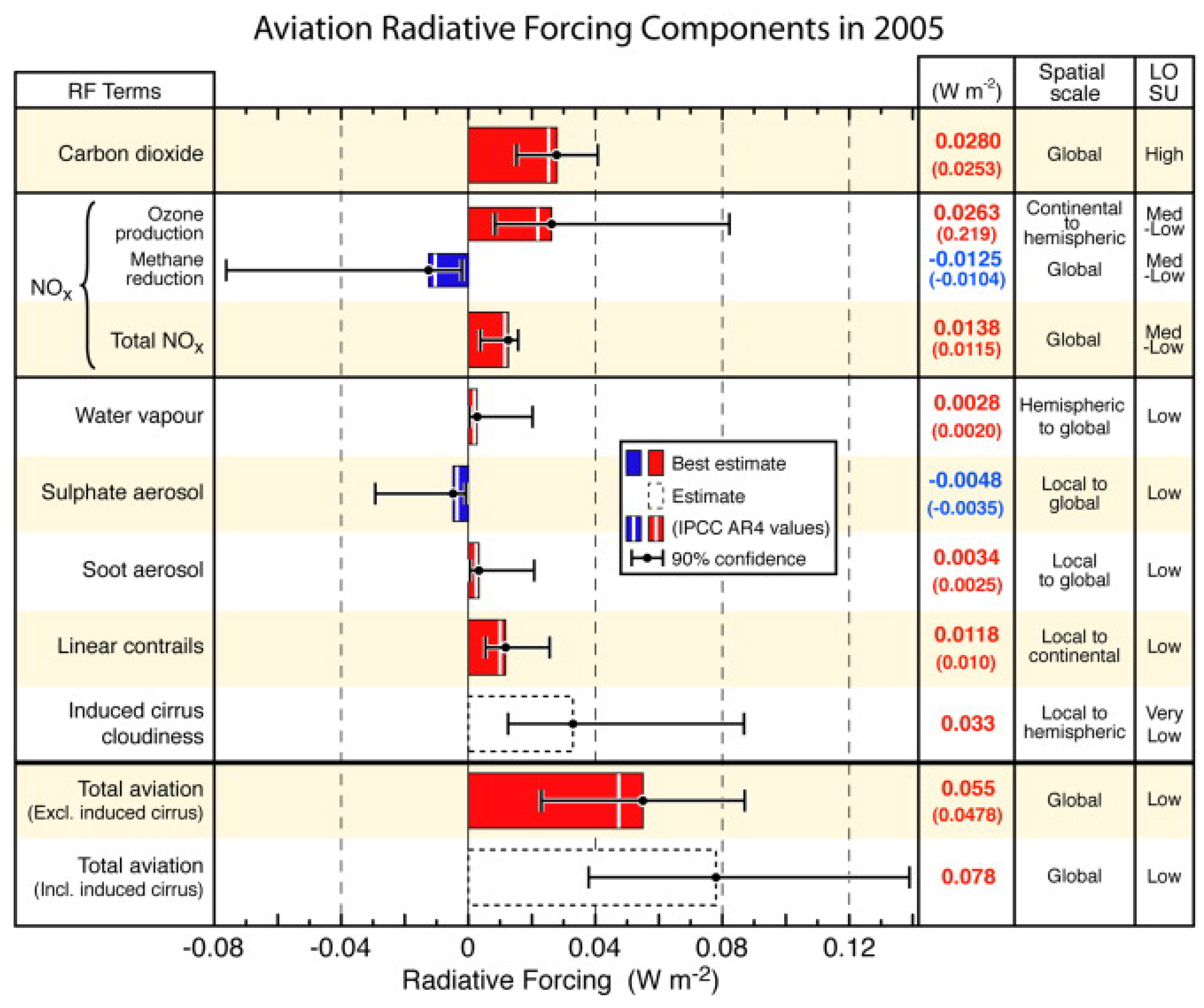
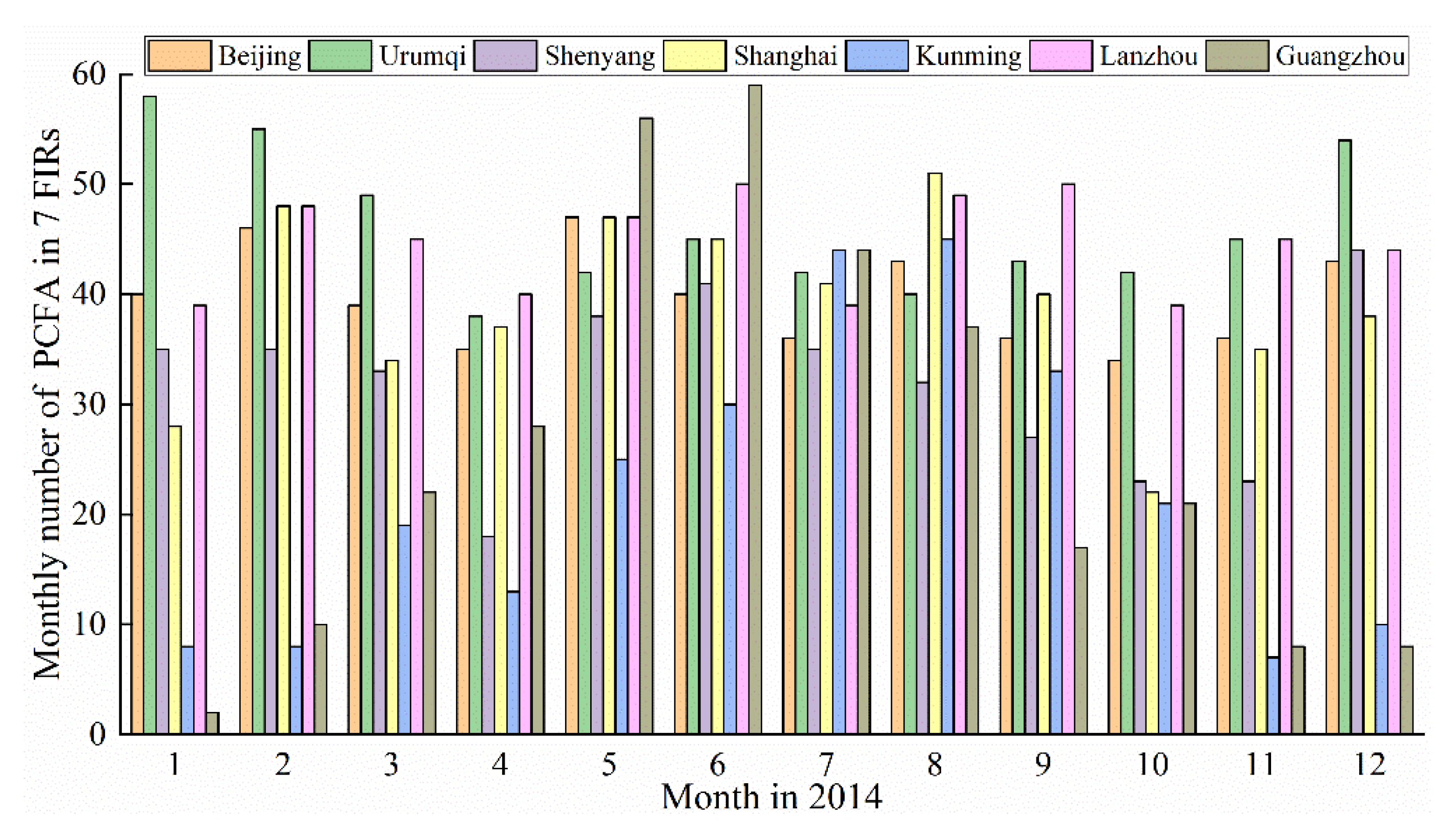
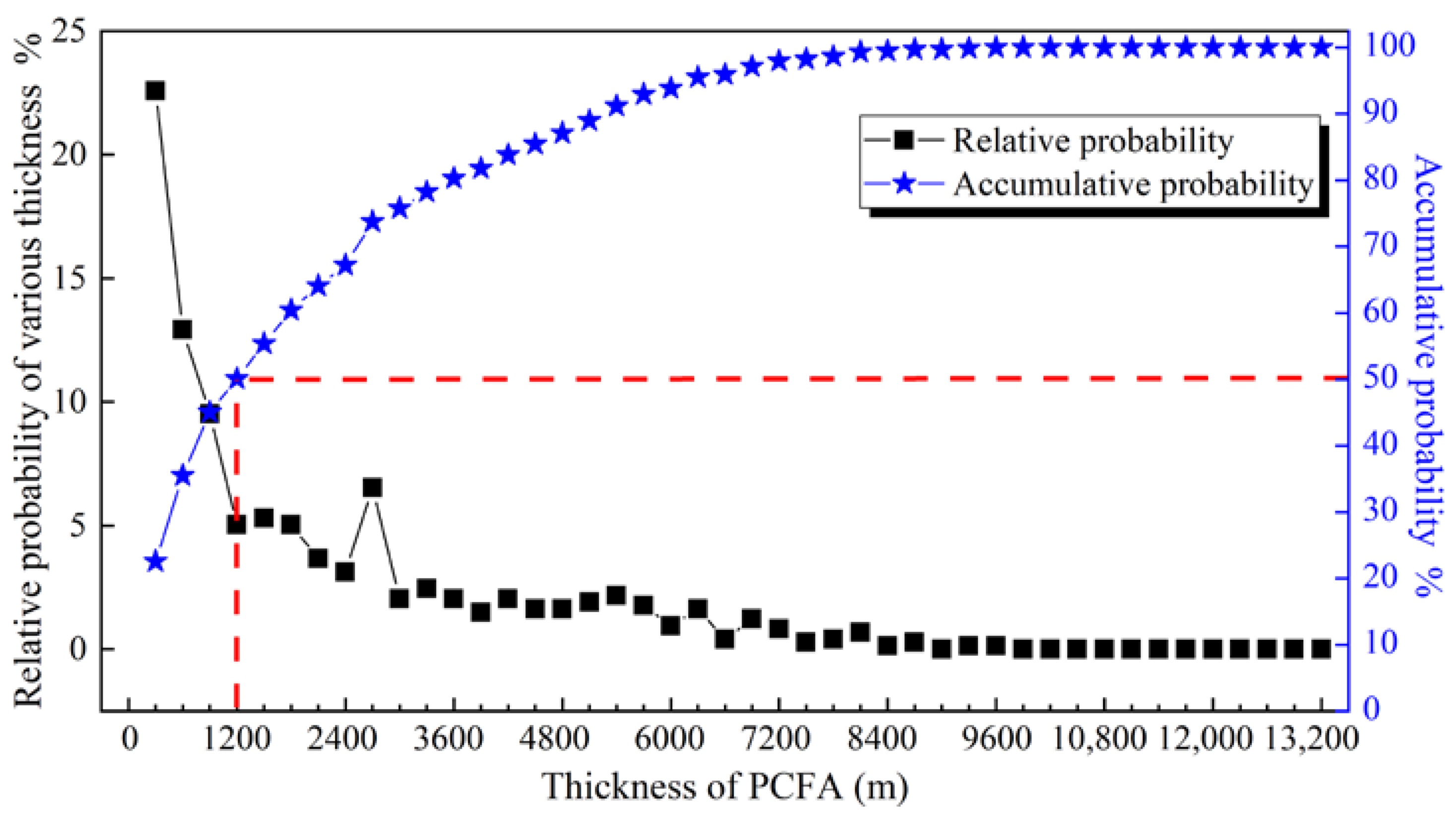
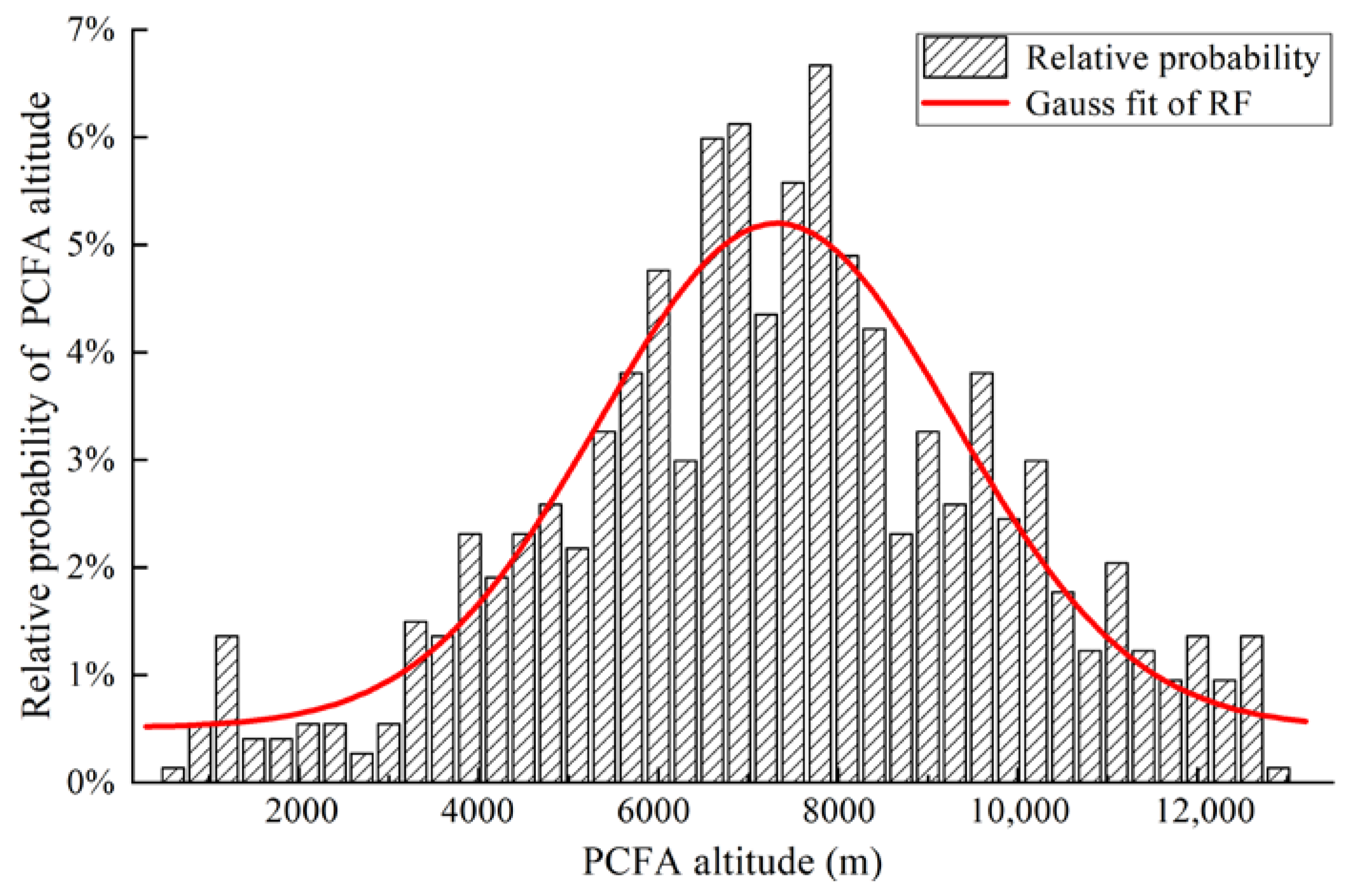
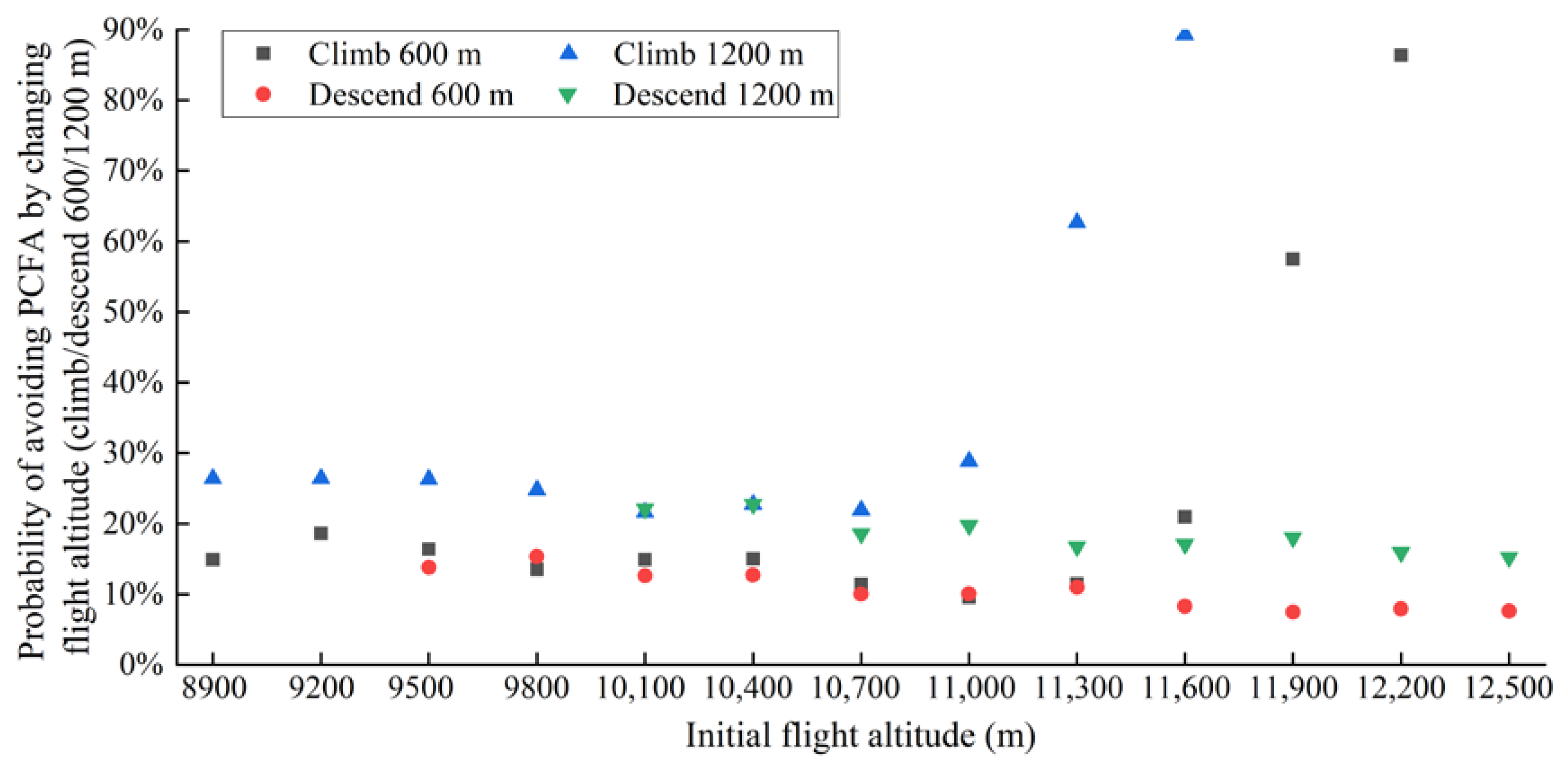
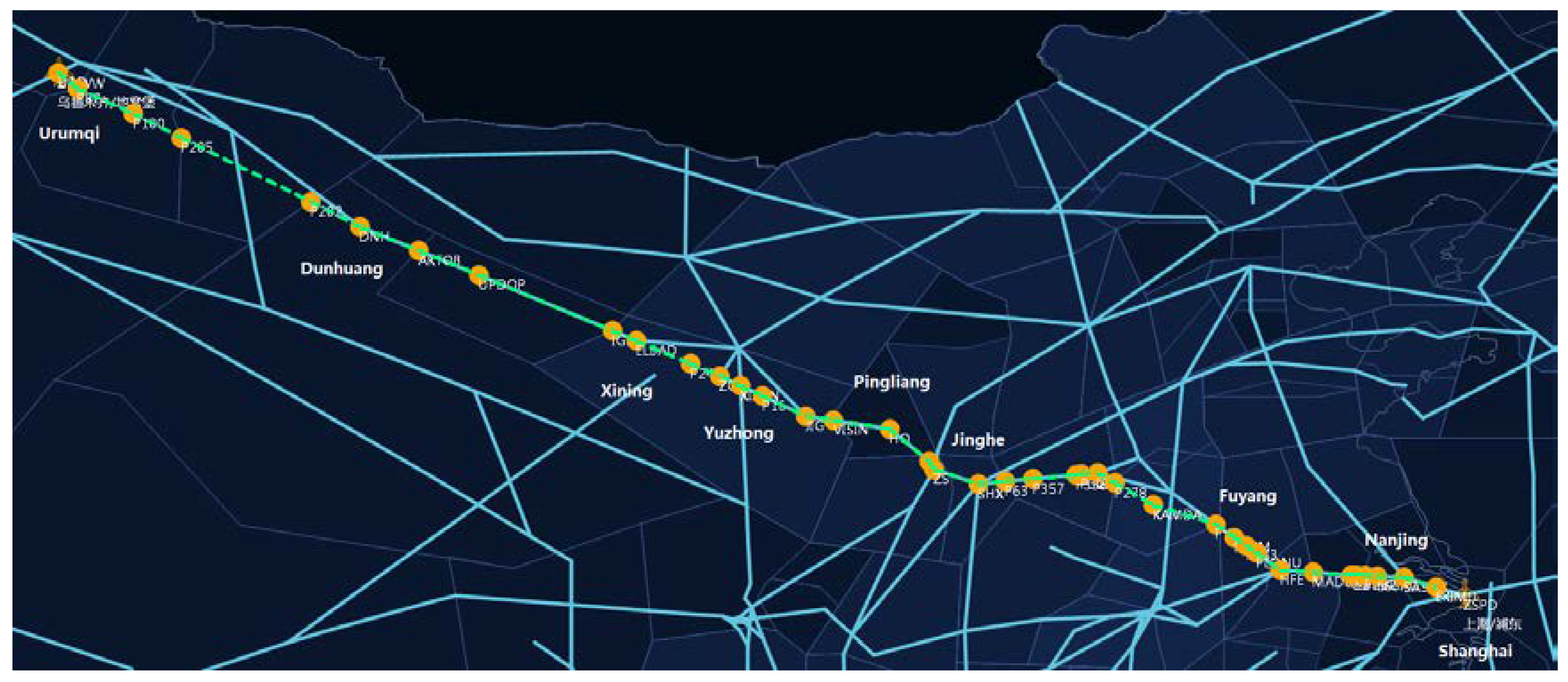



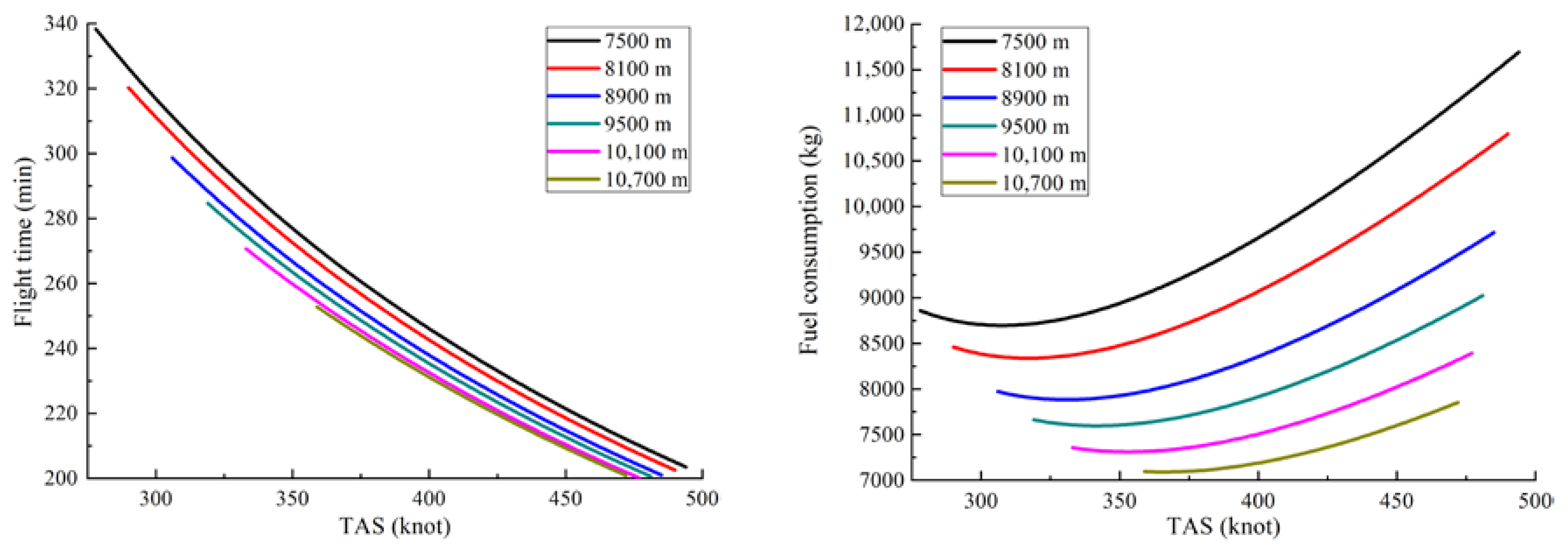


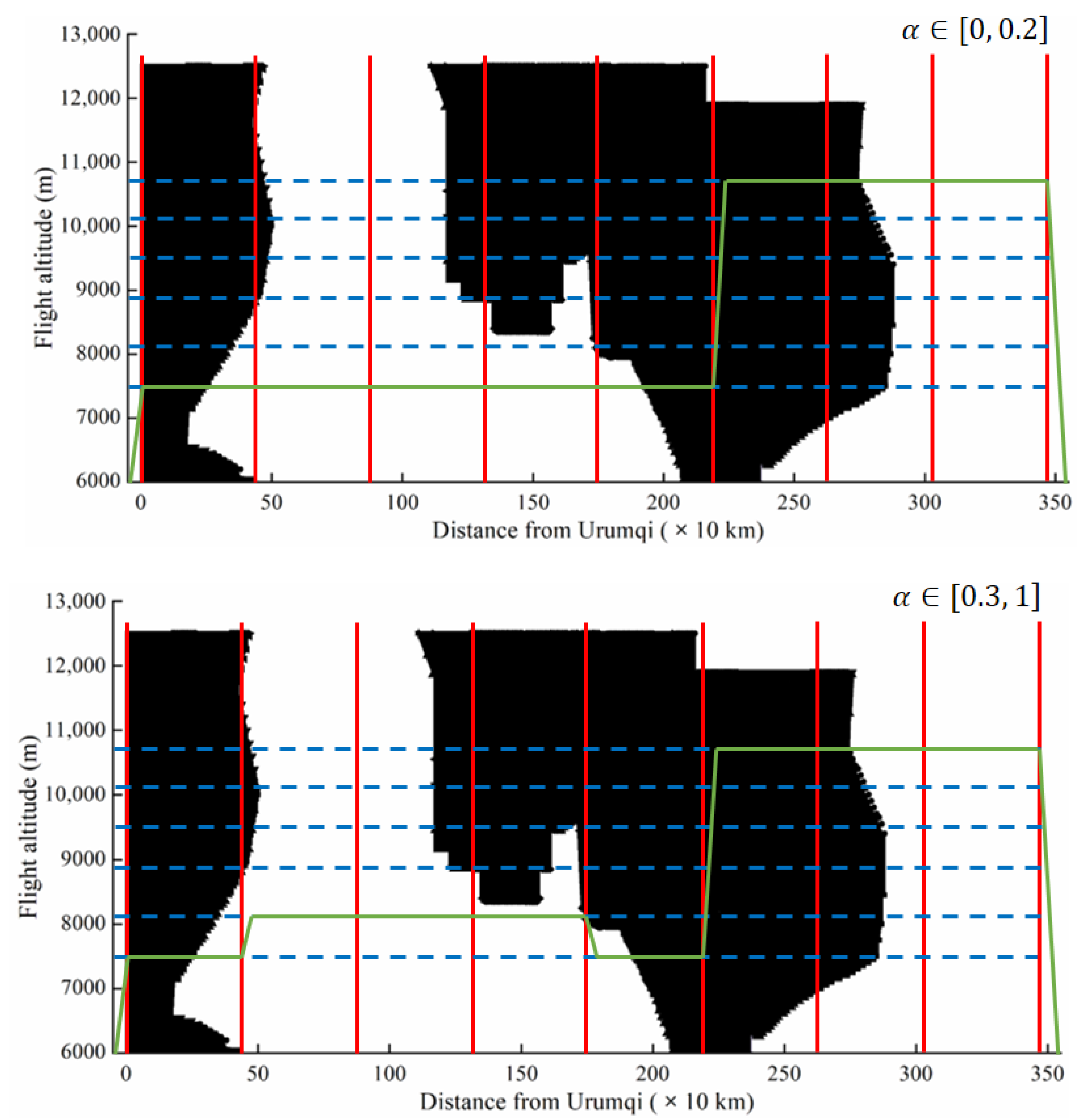
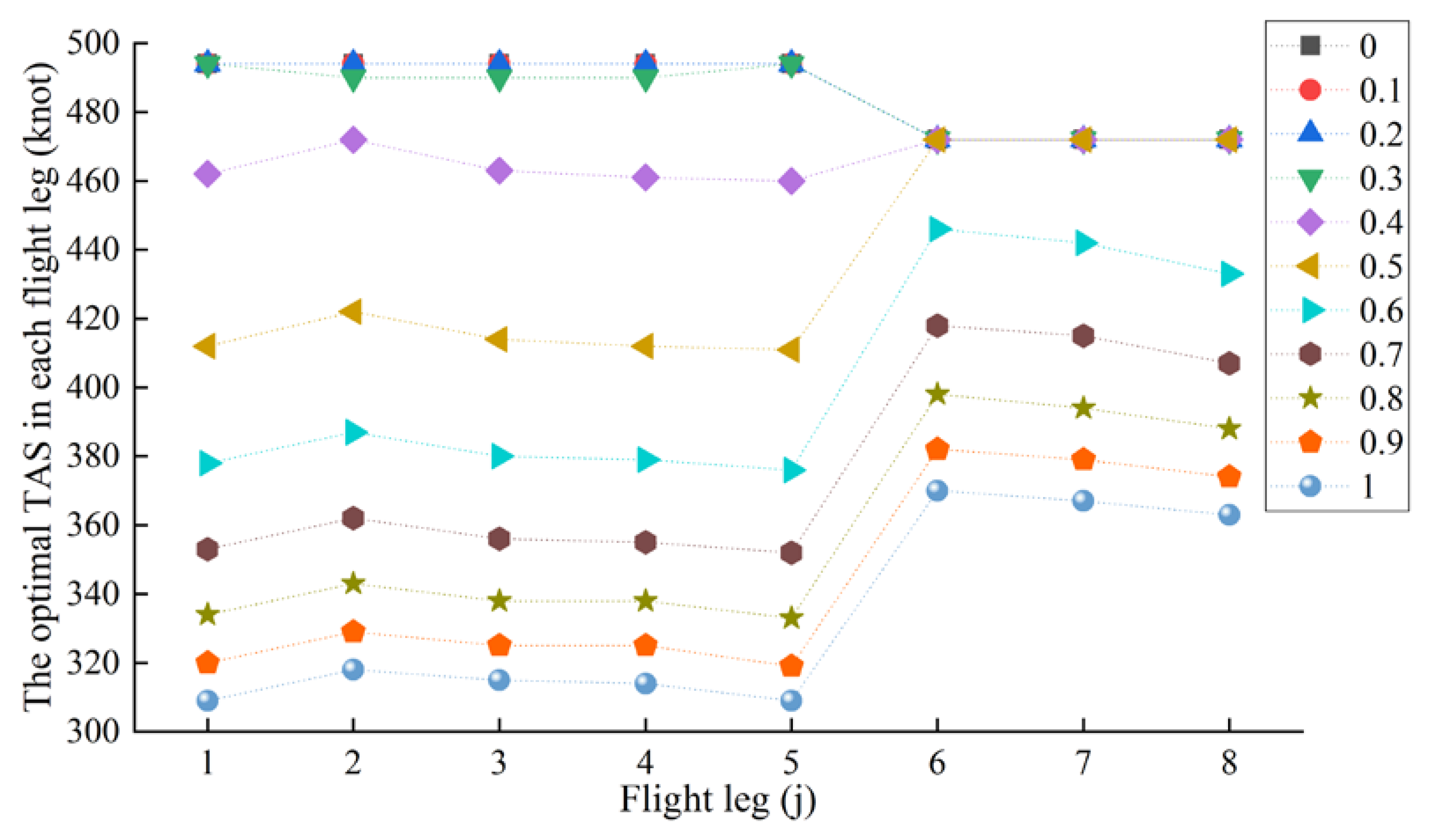

| Time (min) | Fuel (kg) | Flight Alt (m) | |
|---|---|---|---|
| 0 | 199.9778 | 8401.241 | 10,100 |
| 0.1 | 200.7956 | 7863.281 | 10,700 |
| 0.2 | 200.7956 | 7863.281 | 10,700 |
| 0.3 | 200.7956 | 7863.281 | 10,700 |
| 0.4 | 200.7956 | 7863.281 | 10,700 |
| 0.5 | 200.7956 | 7863.281 | 10,700 |
| 0.6 | 213.9948 | 7489.067 | 10,700 |
| 0.7 | 225.3267 | 7272.985 | 10,700 |
| 0.8 | 234.8992 | 7159.446 | 10,700 |
| 0.9 | 242.633 | 7111.111 | 10,700 |
| 1 | 248.638 | 7099.289 | 10,700 |
| Fuel (kg) | Time (min) | Contrail (km) | Fuel (kg) | Time (min) | Contrail (km) | |
|---|---|---|---|---|---|---|
| 0 | 7982 | 204 | 2050 | 10,706 | 210 | 1070 |
| 0.1 | 7982 | 204 | 2050 | 10,706 | 210 | 1070 |
| 0.2 | 7982 | 204 | 2050 | 10,706 | 210 | 1070 |
| 0.3 | 7982 | 204 | 2050 | 10,474 | 212 | 1070 |
| 0.4 | 7982 | 204 | 2050 | 10,074 | 219 | 1070 |
| 0.5 | 7980 | 204 | 2050 | 9461 | 233 | 1070 |
| 0.6 | 7641 | 216 | 2050 | 8986 | 249 | 1070 |
| 0.7 | 7412 | 228 | 2050 | 8720 | 263 | 1070 |
| 0.8 | 7296 | 238 | 2050 | 8583 | 275 | 1070 |
| 0.9 | 7244 | 246 | 2050 | 8525 | 284 | 1070 |
| 1.0 | 7232 | 253 | 2050 | 8510 | 292 | 1070 |
© 2020 by the authors. Licensee MDPI, Basel, Switzerland. This article is an open access article distributed under the terms and conditions of the Creative Commons Attribution (CC BY) license (http://creativecommons.org/licenses/by/4.0/).
Share and Cite
Xue, D.; Ng, K.K.H.; Hsu, L.-T. Multi-Objective Flight Altitude Decision Considering Contrails, Fuel Consumption and Flight Time. Sustainability 2020, 12, 6253. https://doi.org/10.3390/su12156253
Xue D, Ng KKH, Hsu L-T. Multi-Objective Flight Altitude Decision Considering Contrails, Fuel Consumption and Flight Time. Sustainability. 2020; 12(15):6253. https://doi.org/10.3390/su12156253
Chicago/Turabian StyleXue, Dabin, Kam K. H. Ng, and Li-Ta Hsu. 2020. "Multi-Objective Flight Altitude Decision Considering Contrails, Fuel Consumption and Flight Time" Sustainability 12, no. 15: 6253. https://doi.org/10.3390/su12156253





